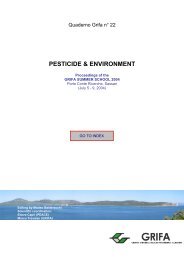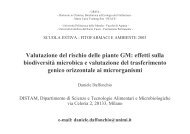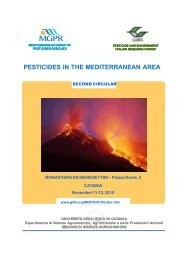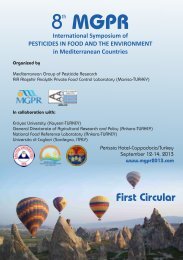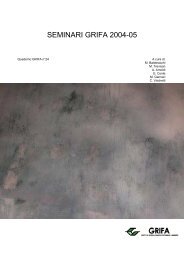International Congress BIOLOGICAL PRODUCTS - Gruppo di ...
International Congress BIOLOGICAL PRODUCTS - Gruppo di ...
International Congress BIOLOGICAL PRODUCTS - Gruppo di ...
You also want an ePaper? Increase the reach of your titles
YUMPU automatically turns print PDFs into web optimized ePapers that Google loves.
Supelco Supelclean LC-18 SPE tubes (3ml). The other phenolic compoundswere quercetin, rutin (quercetin-3-Orutinoside),<br />
kaempferol, kaempferol-3-glucoside, kaempferol-3-rutinoside, rhamnetin, isorhamnetin, and were<br />
also supplied by Sigma.<br />
Wine Analysed<br />
The analyses were carried out on 23 Italian wine samples (red and white), coming from three <strong>di</strong>fferent Italian<br />
vineyards: one located in Tuscany, one in Campania and one in Sicily. In particular, wines from Tuscany were<br />
produced from 30 years old plants (vines were grafted with Sangiovese variety, Morellino clone) and each sample<br />
was vinified red. Wines from Campania were produced from 20 years old plants (vines were grafted with Fiano<br />
d’Avellino variety) and each sample was vinified white. Sicilian wines were produced from 15-20 years old<br />
plants (vines were grafted with Inzolia and Carricante variety in ratio 1:1) and each sample was vinified white.<br />
The vineyard was sub<strong>di</strong>vided in thesis; each thesis consisted of four rows of vines and the remotest was located<br />
with the function to prevent drift effect. The fungicides treatments were carried out at the end of blossoming and<br />
maturation. The scheme of experimental work provided the treatment of each thesis with <strong>di</strong>fferent antioi<strong>di</strong>cs and<br />
antiperonosporics: sulphur, azoxystrobin, <strong>di</strong>nocap, penconazolo, fenarimol, quinoxyfen (tab.1).<br />
Analysis of cis- and trans-resveratrolo<br />
cis- and trans-resveratrol were extracted from wines using the SPE cartridges prior to the HPLC analysis. For the<br />
analysis of total wine resveratrol was used an enzymatic hydrolysis method, improved by our working group (25).<br />
The wine resveratrol O-glycosides (trans- and cis-piceid) were totally hydrolysed in ~ 9 hours after incubation<br />
with β-glucosidase at 50°C; then the trans- and cis-aglycones were measured by HPLC after solid phase<br />
extraction (SPE). An ODS Hypersil 5µm (250x4,6 mm i.d.) column was used as the stationary phase and was<br />
preceded by a precolumn of the same material. The mobile phase consisted of phase (A) water/acetic acid (pH =<br />
3) and phase (B) acetonitrile/acetic acid (pH = 3). cis- and trans-resveratrol were eluted with a gra<strong>di</strong>ent time<br />
program and the eluted was monitored at 285 and 307 nm, where cis- and trans- isomers have absorbance<br />
maxima, respectively. All chromatographic experiments were performed at room temperature with a flow rate<br />
1ml/min. The chromatograms were recorded accor<strong>di</strong>ng to the retention time. Before the HPLC analysis the<br />
extract were filtered through a 0,45µm glass-microfiber GMF Whatman chromatographic filter.<br />
HPLC analysis methodology for flavonoids<br />
The analysis were carried out on aliquot of wine filtered through a 0,45 µm nylon Supelco chromatographic filter,<br />
using an HPLC system operating at room temperature with a flow–rate of 0,8 ml/min.. The spectrophotometric<br />
detector was a photo<strong>di</strong>ode array operating at wavelengths of 265 nm for aglycon-flavonoids and 254 for<br />
flavonoid-glucoside. The analytical column was a Alltech Alltime C-18, 5 µm ( 250 x 4,6 mm i.d.). A SUPELCO<br />
guard column packed with the same stationary phase was also used. The mobile phase consisted of<br />
H2O/CH3COOH at pH= 3 (phase A) and CH3CN/CH3COOH at pH = 3 (phase B). Elution was carried out in<br />
gra<strong>di</strong>ent.<br />
RESULTS AND DISCUSSION<br />
Analytical data related to the free isomeric forms of resveratrol (cis- and trans-) and to the total resveratrol (free<br />
and glucosides isomers) are reported in fig. 1,2 and 3. This investigation, once again, clearly shows that red wines<br />
have a greater resveratrol content than white wines, regardless of the pesticide treatments of the vines. Analysing<br />
the data related to wines from Campania, it can be noticed that in the samples Thesis 3, 4, 5 and 6 the amount of<br />
cis-resveratrol is between 0.04 and 0.05 mg/L, while the samples Thesis 1, Thesis 2 and Thesis 7 have an amount<br />
of cis-resveratrol impossible to verify with the adopted analytic method. The concentration of trans-resveratrol<br />
results highest in the sample Thesis 5 (0.13 mg/L), and a lowest in the sample Thesis 3 (0.07 mg/L). The total<br />
concentration of cis- and trans-resveratrol deserve a particular attention because, generally, it is similar in every<br />
sample while, this balance does not occur in free form of cis- and trans-resveratrol. In fact, the concentration of<br />
free trans-resveratrol is a little lower than that of total trans-resveratrol, but in sample Thesis 2 it is even almost<br />
identical; the same situation does not occur in cis-resveratrol. Examining the concentration of free cis-resveratrol<br />
to that of total, it results that the amount of cis-piceid is much higher than that of trans-piceid, regardless of the<br />
pesticides treatment. A completely <strong>di</strong>fferent situation is shown for wines produced and vinified in Sicily. In this<br />
case, the concentration of total trans-resveratrol (between 0.17 and 0.34 mg/L) is always higher than that of total<br />
cis-resveratrol (between 0.09 and 0.20 mg/L). Moreover, <strong>di</strong>fferently from what was noticed in wines produced<br />
and vinified in Campania, the cis- and trans-piceid concentration in each sample is comparable, and is between a<br />
minimum value of 0.03 mg/L and a maximum of 0.18 mg/L. The samples Thesis 4 and Thesis 5 <strong>di</strong>ffer from this<br />
general trend, as they are characterized by an amount of cis-piceid clearly higher than that of trans-isomer. As<br />
shown in fig.3, the wines obtained from cv Sangiovese have very <strong>di</strong>fferent quantities of free trans-resveratrol and<br />
they range from 0.22 to 1.76 mg/L. The same trend can be noticed with free cis-resveratrol, but in this case the<br />
concentrations are more homogeneous. Comparing total cis- and trans-resveratrol concentrations to those of the<br />
equivalent free isomers, it emerges that the levels of trans-piceid are approximately twice as high as those of the<br />
correspon<strong>di</strong>ng cis-piceid, except for samples Thesis 4 and Thesis 5 that present comparable levels. The<br />
PDF creato con FinePrint pdfFactory versione <strong>di</strong>mostrativa http://www.secom.re.it/fineprint<br />
99



